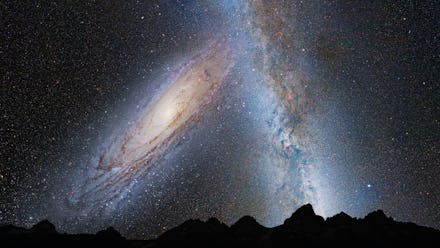A New Theory About Our Galaxy Means We Might Be Totally Wrong About Gravity

For a long time, astronomers have told us our galaxy is on a collision course with the neighboring Andromeda galaxy — and the cataclysmic crash will likely happen in about 3 billion to 4 billion years from now. But another group of scientists say we already bumped into Andromeda 10 billion years ago and lived to tell the tale.
If they're right, it means everything we think we know about gravity is wrong.
Gravity doesn't make sense.
Everything we've observed about the universe seems to indicate that it's expanding, and all the galaxies are getting farther and farther apart. So then how can our galaxy be on a collision course with another?
The Milky Way is part of a group of galaxies called the Local Group. Cosmologists think most of the matter in the Local Group is invisible and composed of a mysterious material called dark matter. The gravitational effect of all that extra matter could explain why the Milky Way and Andromeda are hurtling toward each other.
In other words, dark matter can explain the bizarre gravitational discrepancies we see in the universe.
But Hongsheng Zhao and a team of cosmologists have a different idea. Their theory builds on another theory called Modified Newtonian Dynamics, or MOND, which describes how gravity seems to behave differently on the galactic scale than it does on smaller scales.
Zhao and his team used MOND to model the Local Group of galaxies. Their model showed that the Milky Way and Andromeda bumped into each other about 10 billion years ago.
If the team is right, it would be a very good explanation for the current arrangement of galaxies within the Local Group, and we'd no longer need dark matter to explain the gravitational effects we see.
"But if [the MOND] theory is right, then there are no dark particles, and the two large galaxies could have simply passed each other — thereby drawing matter from each other into long thin tidal arms," Benoit Famaey, a researcher who worked on the theory, told Sci News.
If dark matter exists, it would have caused the two galaxies to stick together, the team says. They also say that the Milky Way and Andromeda are still heading for a collision, but it might not be the cataclysmic destruction we've been warned about.
Instead, it might look more like this previous gentle bump.
More evidence
Now the team has even more evidence to support their theory. In a follow-up paper published on the preprint server arXiv in March, Zhao and a student ran additional models of the Local Group. They found that some of the smaller galaxies are moving way too fast for dark matter to explain. A previous collision between the larger Milky Way and Andromeda galaxies could explain their superspeed.
"So if you think [of the Milky Way and Andromeda] as parents, these little ones were first gravitationally bounded by the parents, but after the collision of the parent galaxies, they are ejected out," Zhao wrote in an email to Mic on Thursday. "Their rogue velocities are relics of the collision."
We'll need a lot more research and testing, but this could have profound implications for all of physics and cosmology.